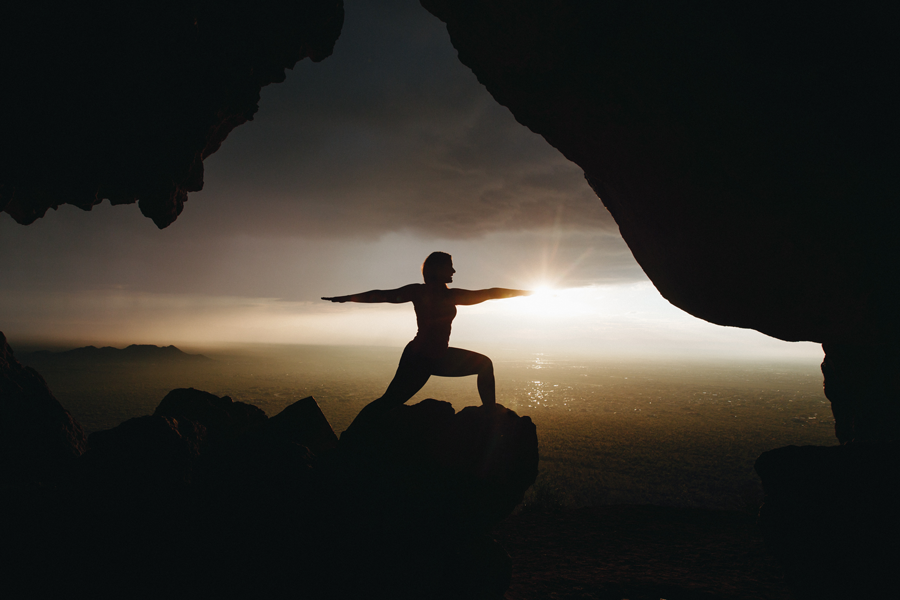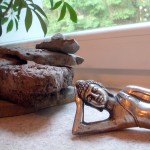Are you in your body?
Pause and examine your experience. Right now. Before reading further.
I don’t mean that I want a catalog of your sensations, your thoughts and emotions. Observing and cataloging is one way to connect with your somatic experience. It’s a core technique in many mindfulness practices.
But observing and cataloging is still one step away from actually experiencing your body, from actually being in your experience.
So are you in your body?
Our Body as a Bridge to the Present
Reginald A. Ray is a Buddhist teacher and academic. In his book “Touching Enlightenment: Finding Realization in the Body,” he explores why being embodied is central to being enlightened, present, and awake.
He writes that one of the reasons our meditation practice becomes stale and hits a wall is that we don’t fully embody our experience. At different times, we may have thoughts about our bodies or we may observe the sensations we’re experiencing. But often, we keep ourselves at arms length from true embodiment by remaining conceptual.
For this reason, Reggie feels meditation is not enough. To be fully present, you have to be fully and completely in your body.
In my classes, we often explore what it means to be embodied. We use our bodies as a bridge to the present moment. Bodies don’t live in the past or the future–only now. So by fully inhabiting our bodies, we have a way to experience what is truly happening now.
“Embodiment” in Modern Yoga
If I asked you how to connect with your body, you might answer “yoga”. Yoga is understood as a mind/body practice and it often includes meditation. It makes sense that it might be a means to embodiment.
But unfortunately, many yoga practices (and classes) fall short of teaching this. Filled with wild, contorted, stretchy-bendy poses, ego-driven flows, and up-regulating sequences, these practices teach you master your body–not inhabit it.
Using yoga poses like this produces a lot of sensation and a lot of narrative. You become attached to the poses and and the way you feel during them. Your mind wills your body to perform. And when the physical exertion is too intense, you withdraw and contract from the experience. When the physical exertion isn’t enough, you become bored and disengaged.
In effect, you learn the opposite of embodiment.
True Embodiment in Yoga
Just because some yoga practices don’t teach embodiment, doesn’t mean they all don’t. You just need to find the ones. You need to find yoga that understands the poses not as physical shapes but as opportunities to inhabit your body.
It’s not hard to give this a try.
Pick a pose which is fairly easy for you. Mountain pose, Dog pose, or Warrior II are good places to start. You could even just lie on the floor.
Assume the pose in a way that is comfortable for your body. In other words, if your hamstrings are tight, bend your knees in Dog. If Warrior II is strenuous, don’t bend your front knee as far. Don’t worry about creating the exact shape that you see in the yoga books. Just approximate the posture in a way that is comfortable for your body.
Once you have the shape, rest in it.
At the start, you’ll probably notice all the sensations. That’s normal because they are most obvious. You may feel your hamstrings. You may notice the weight on your feet. Maybe you’ll feel your jaw clenched or your shoulders tight.
After you catalog your sensations, go deeper. Draw your attention to the non-sensations. What parts of your body feel nothing? What does it feel like to feel nothing? For example, if the back of your head feels nothing, what does that nothingness feel like?
Just be Present
And finally, after exploring the lack of sensation, allow your mind to rest and just be present. There’s no need to tweak the pose or fix your alignment. There’s no need to bring awareness to your body. In fact, there’s no need to do anything at all. Just experience being in the pose–whatever that is for you.
With this kind of yoga, you’ll notice that the shape of your body plays a minor role. Your body can be straight or bendy, upside-down or rightside-up. You’re simply using the pose as a means to experience your body. And ultimately, you’re using your body to experience being present.
You can understand yoga in different ways. In one way, yoga is a series of postures. You move your body into various shapes and work to gain mastery over the postures.
In the other way, yoga is a means to explore embodiment. You move your body to explore what it means to truly inhabit it. You use your body to be present and fully awake.
The next time you think your meditation practice feels stuck or stale, try something new–try being present in your body. Take a yoga class and as you do your practice, ask yourself if you are in your body. Use the poses to explore embodiment. Maybe, as Reggie Ray writes, being in your body will take you closer to being truly present.




I stopped taking yoga classes at studios because of the lack of embodiment, or the lack of teaching of embodiment and it hurt my practice in a big way. I know it’s on me but I tuned out of yoga for many years.
Recently, I started a home practice again and it’s amazing how much it helps with my meditation practice!
Hi Charles,
I hear you. Yoga has come to mean many different things, many of which have nothing to do with becoming more centered, grounded, and whole. I’m so glad that ultimately, your own home practice ended up helping your meditation. What does your home practice look like? What are some of the ways it helps your meditation?
As a senior citizen I do a 1 hour walk every morning, also will do stretches with this, but no yoga as such. I do associate with those who do and lead yoga classes. It has been suggested I read ” Light On Life ” by Iyengar’s to further understand what yoga is all about. I was enjoying Iyyengas”s book, until I found a video of him teaching a class. This video has removed much of my enjoyment of what yoga is from his perspective. I like to be open minded as much as possible but simply can NOT accept the necessity or the extent that he does as you have called the bend-twisty distortions. These extremes I can not accept as being a prerequisite to awakening, wakening to any sort of divine awareness.
I have been a believer in and practiced meditation and mindfulness for over 40 years in its many forms. All have lead me to being still, listening to that other side of silence, listening to the body’s presence from the deep altered state of consciousness, the alpha, beta state of being. So when I read your presentation on ” how to boost your meditation with embodiment “, I felt, sensed something, like a beautiful song of a bird in early dawn. There is so much truth in what you have presented …. thank you much.
Bill, that’s beautiful. Thank you very much. I can’t add anything because you have said it so well.
May your practice continue to give you divine awareness and the peace of just being.
Nice Post.
Thank you, Alina
Thank you Julia, I don’t practice yoga but have been meditating for nine years and meditation has been a beautiful support for presence and embodiment. I also have the privilege of sharing the practice with others through teaching.
For those of us with anxiety, depression, pain or trauma sometimes mindfulness of breathing can be more activating than feels manageable. I wanted to share a way of working with this in case any of your readers experience this.
An accessible and less activating meditation technique can be to open to sound and use sound as the object of meditation. Like the body, it’s also in the present. So, just settling into a comfortable way of sitting and then letting your awareness open to sound – just whatever sounds are happening. After a few minutes of receptive listening, the attention can then be brought gradually into contact with the feeling of breathing. I hope some of your readers find this helpful.
Thank you, Danny. Sound is a lovely meditation tool.